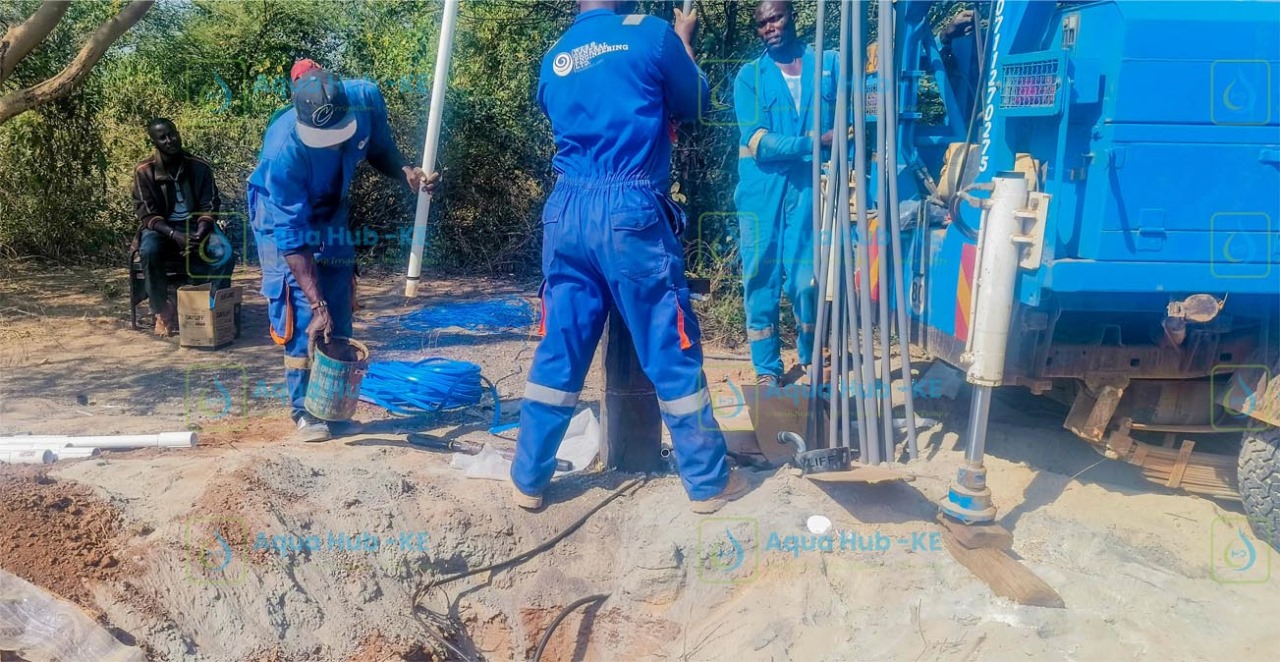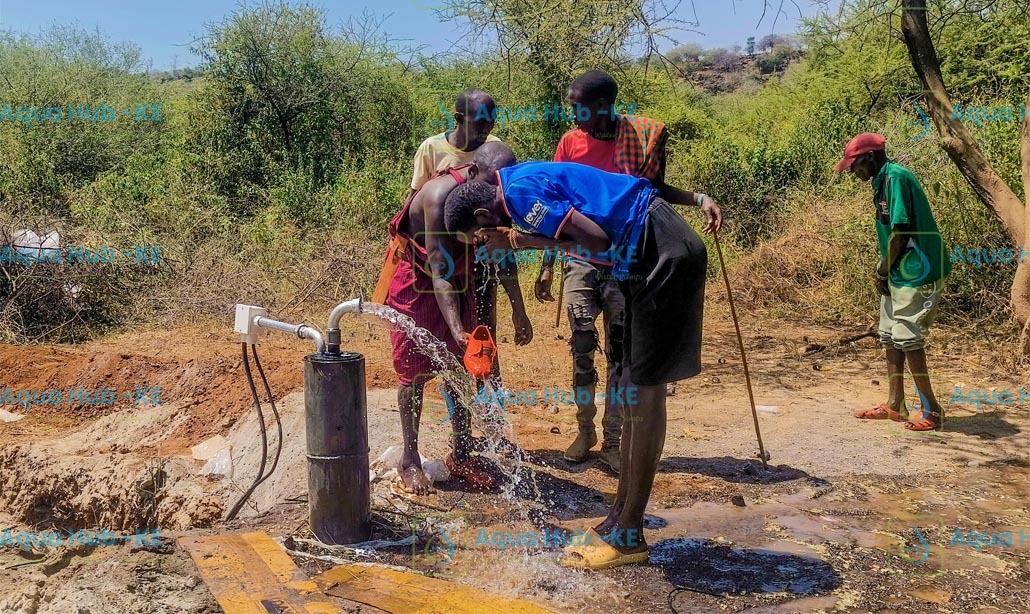Blog
Borehole Servicing and Equipping with Pump Set

Borehole Servicing. Boreholes provide water for domestic, agricultural and industrial applications especially in areas with lower municipal or clean water supply.
To access reliable and consistent water supply, you must go beyond borehole drilling to ensuring proper borehole servicing and equipping.
This article explores everything that you should know about borehole servicing, equipping with the right pump, cover and solar power supply.
Borehole Servicing and Pumps by Aqua Hub LTD
Get Solar Pumps, Submersible borehole pumps, borehole servicing and equipping with complete solar panels and Power cables from Aqua Hub LTD. We are the reliable supplier with technical expertise in borehole pump sizing and installation.
Call 0790719020
How to Identify the Right Water Pump for Your Borehole
Choosing the correct pump is critical to the efficiency and longevity of your borehole system. The wrong pump can lead to high energy consumption, insufficient water delivery, or even borehole damage. Key factors to consider include:
Flow Rate
Flow rate, measured in liters per minute (LPM) or cubic meters per hour (m³/h), determines how much water your pump can deliver. It should match your water demand for households, farms, or irrigation systems. A typical household may require a flow rate of around 30–60 LPM, while agricultural or commercial uses may need significantly more.
Head (Total Dynamic Head in Meters)
The head is the vertical distance the pump must lift the water, accounting for the depth of the borehole, elevation to the storage tank, and friction loss in the pipes. Total Dynamic Head (TDH) is a crucial parameter. For example, if your borehole is 100 meters deep and your tank is 20 meters above ground, you’ll need a pump that can handle at least 120 meters, plus a safety margin.
Power Requirement (kW)
The power rating of your pump (measured in kilowatts, kW) is tied to both the head and the flow rate. Higher lift and flow rates require more power. Choosing an appropriately powered pump ensures efficiency without overloading your power system.
Motor Type
Most borehole pumps use submersible motors, which are efficient and quiet. Motors can be single-phase or three-phase, depending on your power supply. For off-grid installations, consider brushless DC motors, which are ideal for solar-powered systems.
Borehole Cable Sizing: What You Need to Know
The right cable size ensures that power is delivered efficiently to your pump, reducing energy losses and avoiding overheating. There are several types of cables used in borehole systems:
Submersible Drop Cables
These are special waterproof cables that operate underwater to power submersible pump motor. Cable size depends on:
- Pump power (kW)
- Distance from power source to the pump
- Voltage drop tolerance (usually 3–5%)
A typical submersible pump of 1.5 kW at 220V over 100 meters may require a 6 mm² copper cable. Always consult a cable sizing chart or electrical engineer to confirm.
Laundex Cable
Laundex cables are high-strength cables used to support the submersible pump weight in deep boreholes. They are armored and can handle extreme conditions. These are usually specified by the borehole depth and pump load.
Underground (UG) Cables
Used for supplying power from the main distribution board to the control panel or borehole, UG cables are covered to protect against mechanical damage and moisture. Proper sizing avoids voltage drop and meets safety codes.
Borehole Servicing: Inspection Using Airlines and Electrodes
Routine borehole inspection is vital for early detection of issues like declining yield, contamination, or pump failure. Two main tools used are:
Airlines
Airlines are small-diameter tubes lowered into the borehole to measure the static and dynamic water levels using an air pressure gauge. They help monitor water table changes and diagnose performance issues.
Electrodes
Electrodes or electrical probes measure the borehole’s depth and water conductivity. These readings can detect potential contamination, borehole siltation, or blockage. Digital loggers can be added for real-time data collection.
Regular inspections help prolong your borehole’s life and ensure consistent water supply.
Borehole Cover Complete with Adapter Set
A borehole cover is a lid that is critical for protecting your water source from contamination, physical damage, and unauthorized access.
Features of a Proper Borehole Cover
- Sealed construction to prevent dust, debris, or animals from entering
- Lockable design for security
- Adapter set to facilitate cable and pipe exits while maintaining a seal
- Ventilation ports to avoid condensation buildup
Steel or heavy-duty plastic covers are most common. They should comply with local water safety and construction standards.
How to Solarize the Borehole Pump
Solarizing your borehole system is an eco-friendly and cost-effective way to power your pump, especially in areas with unreliable electricity. Here’s how to do it right:
Power Requirements for the Inverter
The inverter converts DC power from solar panels to AC power for your pump (unless you’re using a DC pump). Match the inverter’s capacity to your pump’s power needs. For instance:
- A 1.5 kW pump requires an inverter rated slightly higher, e.g., 2 kW, to handle start-up surges.
- Consider MPPT inverters for higher efficiency and better performance under variable solar conditions.
Solar Panels Suitable for the Inverter
Choose panels that can meet your inverter’s input voltage and current requirements. For example:
- A 2-kW system might require 6 to 8 solar panels rated at 330W each.
- opt for tier-1 monocrystalline panels for better efficiency and durability.
- Ensure proper wiring (series or parallel) to meet voltage and current specs of the inverter.
Borehole Servicing : Solar Structures to Accommodate the Panels
Your solar structure should:
- Be tilted at an angle matching your latitude for optimal sun exposure
- Be made of galvanized steel or aluminium for durability
- Allow easy maintenance access
Ground-mounted or elevated structures can be used depending on available space and security considerations.
Delivery Pipes from Borehole to Tank
Use HDPE pipes or PVC Class C pipes, depending on pressure requirements. Factors to consider include:
- Pump capacity: Choose a pipe diameter that allows efficient flow without too much pressure drop.
- Elevation: Ensure pipes can handle the pressure from the pump head.
- Durability: Use UV-stabilized materials for above-ground sections.
- Install non-return valves and isolation valves as needed to maintain pressure and control flow.
Investing in quality components and regular servicing can help your borehole deliver clean, reliable water for decades to come. Whether you’re setting up a new system or upgrading an old one, use this guide to ensure every drop counts.
Borehole Servicing in Kenya: How to find the right Pump Supplier

Always choose the right supplier when buying borehole water pumps to ensure you get the best performance and durable pump. Ensure you consider:
Cost
The cost of the pumps varies depending on their sizes, brand and performance curves. Depending on your budget, go for a pump that offers value for your money. Top brands such as Davis and Shirtliff, Pedrollo and Grundfos are the reliable options.
Servicing or Installation
Buy from a supplier who can provide installation or maintenance service of your pump to cut costs and inconvenience of looking for technicians to install.
